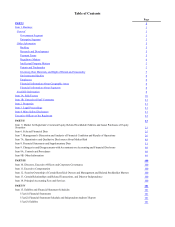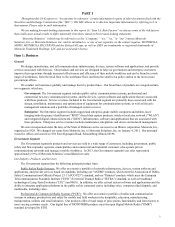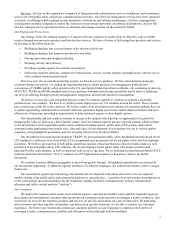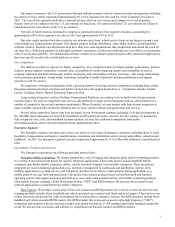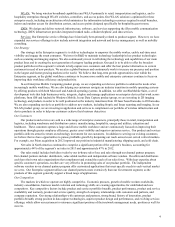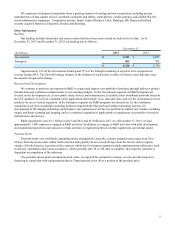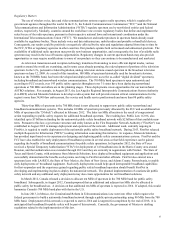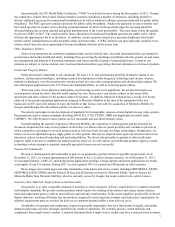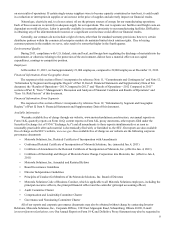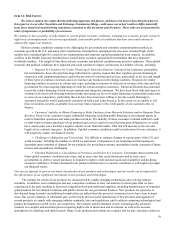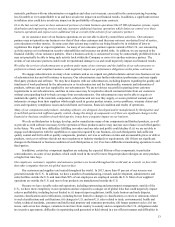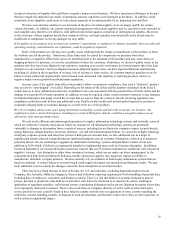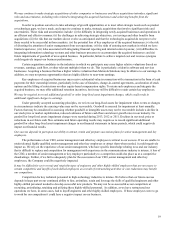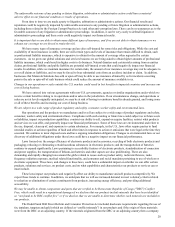Motorola 2013 Annual Report Download - page 12
Download and view the complete annual report
Please find page 12 of the 2013 Motorola annual report below. You can navigate through the pages in the report by either clicking on the pages listed below, or by using the keyword search tool below to find specific information within the annual report.10
Item 1A: Risk Factors
We wish to caution the reader that the following important risk factors, and those risk factors described elsewhere in
this report or in our other Securities and Exchange Commission filings, could cause our actual results to differ materially
from those stated in forward-looking statements contained in this document and elsewhere. These risks are not presented in
order of importance or probability of occurrence.
We continue to face a number of risks related to current global economic conditions, including low economic growth, relatively
high levels of unemployment, risk of sovereign defaults, and unstable political conditions that have and could continue to
unfavorably impact our business.
Global economic conditions continue to be challenging for government and enterprise communications markets, as
economic growth in the U.S. and many other countries has remained low, unemployment rates have remained high, credit
markets have remained tight for certain of our counterparties and corporate capital spending has been reduced. In addition,
conflicts in the Middle East and elsewhere have created many economic and political uncertainties that have impacted
worldwide markets. The length of time these adverse economic and political conditions may persist is unknown. These global
economic and political conditions have impacted and could continue to impact our business in a number of ways, including:
• Requests by Customers for Vendor Financing by Motorola Solutions: Certain of our customers, particularly,
but not limited to, those who purchase large infrastructure systems, request that their suppliers provide financing in
connection with equipment purchases and/or the provision of solutions and services, particularly as the size and length
of these types of contracts increases and as we increase our business in developing countries. Requests for vendor
financing continue to increase in volume and scope, including in response to reduced tax revenue at the state and local
government level and ongoing tightening of credit for certain enterprise customers. Motorola Solutions has continued
to provide vendor financing to both our government and enterprise customers. We have been faced with and expect to
continue to be faced with choosing between further increasing our level of vendor financing or potentially losing sales,
as some of our competitors, particularly those in Asia, have been more willing to provide vendor financing to
customers around the world, particularly customers in Africa and Latin America. To the extent we are unable to sell
these receivables on terms acceptable to us we may retain exposure to the credit quality of our customers who we
finance.
• Customers' Inability to Obtain Financing to Make Purchases from Motorola Solutions and/or Maintain Their
Business: Some of our customers require substantial financing, including public financing or government grants, in
order to fund their operations and make purchases from us. The inability of these customers to obtain sufficient credit
or other funds to finance purchases of our products and services and/or to meet their payment obligations to us could
have, and in some cases has had, a negative impact on our financial results. This risk will increase as the size and
length of our contracts increases. In addition, if global economic conditions result in insolvencies for our customers, it
will negatively impact our financial results.
• Challenges in Budgeting and Forecasting: It is difficult to estimate changes in various parts of the U.S. and
world economy, including the markets in which we participate. Components of our budgeting and forecasting are
dependent upon estimates of demand for our products, the prevailing economic uncertainties render estimates of future
income and expenditures challenging.
• Potential Deferment or Cancellation of Purchases and Orders by Customers: Uncertainty about current and
future global economic conditions may cause, and in some cases has caused businesses and in some cases
governments to defer or cancel purchases in response to tighter credit and decreased cash availability and declining
consumer confidence. If future demand for our products declines due to economic conditions, it will negatively impact
our financial results.
Our success depends in part on our timely introduction of new products and technologies and our results can be impacted by
the effectiveness of our significant investments in new products and technologies.
The markets for certain of our products are characterized by rapidly changing technologies and evolving industry
standards. In addition, new technologies and new competitors continue to enter our markets at a faster pace than we have
experienced in the past, resulting in increased competition from non-traditional suppliers, including manufacturers of consumer
grade products for our enterprise business and public carriers for our government business. New products are expensive to
develop and bring to market and additional complexities are added when this process is outsourced as we have done in many
cases. Our success depends, in substantial part, on the timely and successful introduction of new products and upgrades of
current products to comply with emerging industry standards, laws and regulations, and to address competing technological and
product developments carried out by our competitors. The research and development of new, technologically-advanced
products is a complex and uncertain process requiring high levels of innovation and investment, as well as the accurate
anticipation of technology and market trends. Many of our products and systems are complex and we may experience delays in


